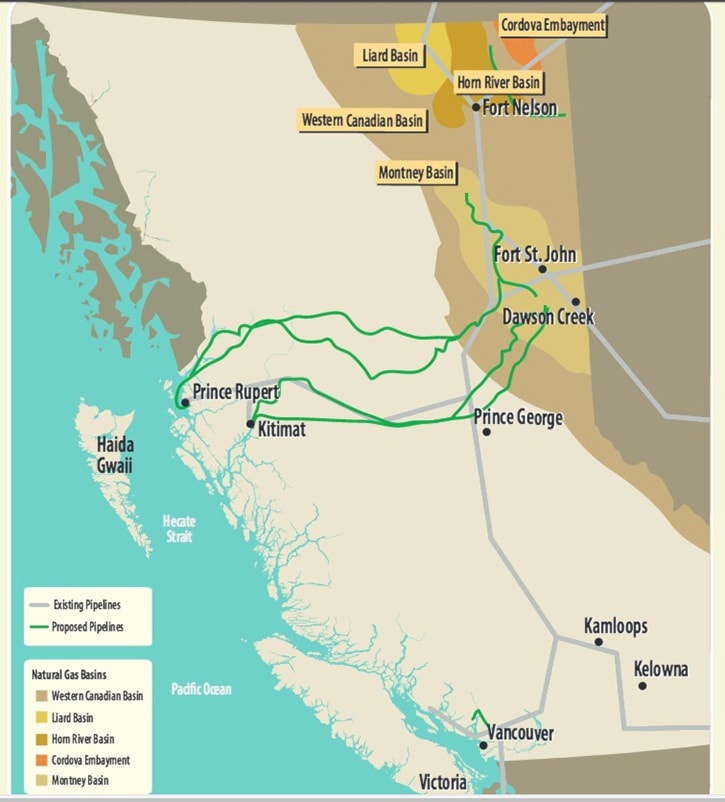MORE THAN 30 northern First Nations have failed to reach an agreement on how to divide $10 million a year for each of three planned pipelines that would carry natural gas to proposed liquefied natural gas (LNG) plants.
The money, a form of a royalty described as an ongoing benefit once the pipelines are in operation, has been offered by the provincial government as part of its overall package of payments to First Nations stemming from the potential of a LNG industry.
But the leaders from the 32 First Nations who have traditional territory through which the pipelines would run from northeastern B.C. to one planned LNG facility at Kitimat and two in Prince Rupert failed to meet a deadline and then an extended deadline over the past 18 months to reach revenue sharing arrangements.
One of those pipelines, TransCanada’s Prince Rupert Gas Transmission, is needed to feed the Pacific NorthWest LNG plant on Lelu Island near Port Edward which received conditional environmental approval from the federal government just this fall.
Majority project owner Petronas of Malaysia is now reviewing the project’s economics before deciding if it will be built or not.
When it first made the financial benefits offer, the province said it would decide itself how to divide the money should First Nations fail to reach their own agreement and now that’s what it will do.
“The province has worked closely with First Nations since the beginning of 2015 to understand what would be the most fair and reasonable ongoing benefit sharing formula,” said a provincial statement last week.
“The province will inform First Nations about an ongoing pipeline benefit distribution model very shortly, since First Nations have been unable to come to agreement on an allocation model.”
“The province has provided technical information to the First Nations, but has not been involved in the First Nations’ decision-making process or recommendations. First Nations have indicated that they wish to know the allocation decision as soon as possible,” the provincial statement continued.
Joe Bevan, the chief councillor of the Kitselas First Nation, which stands to gain from revenue sharing tied to all three pipelines, isn’t surprised a deal wasn’t be reached. “It’s very difficult when you have so many people involved,” he said last week.
At one point participants were being asked to choose between 10 revenue-sharing formulas, Bevan said of the complexity of negotiations.
“It might have been better if there were two or three options,” he said.
There were even questions of what level of approval was needed for First Nations to tell the province they had reached a revenue sharing agreement.
“And at some point you have to draw the line for what you regard as consensus,” said Bevan. “Is it 80 per cent? A 100 per cent?”
In addition to the pipeline to feed Pacific NorthWest LNG, TransCanada’s Coastal GasLink pipeline would supply the Shell majority-owned planned LNG Canada plant at Kitimat and Spectra Energy’s Westcoast Connector would feed the proposed Prince Rupert LNG plant near Prince Rupert.
The failed negotiations were earlier described as complex with issues of whether payments should be divided by the number of kilometres each pipeline would be built through the territory of each First Nation, how overlapping territorial claims would be handled or if individual pipelines should be built at all.
The $10 million annual payment offer is separate from individual agreements struck with First Nations keying on construction of the pipelines.
The Kitselas First Nation has one such agreement with the province covering the pipeline to Kitimat and the two to Prince Rupert.
It stands to receive up to $5.4 million should all three pipelines eventually be built, not counting its share of the $10 million a year in ongoing benefits for each pipeline.
In addition, individual First Nations have also been negotiating separate benefits agreements with pipeline builders, dollar values which so far have been kept confidential.
First Nations along the route of a fourth planned natural gas pipeline, the Pacific Trail Pipeline, which would feed the Chevron-backed Kitimat LNG proposed plant at Kitimat, have their own overall agreement to divide up provincial benefits payments.
It’s worth $32 million with $3 million already being paid and was reached in 2009.
That agreement doesn’t include the $10 million a year based on Pacific Trail being in operation and the province is now working with those First Nations on how it should be divided up.
As with the other three planned pipelines, the Kitselas First Nation would benefit, and it is also part of the overall agreement for Pacific Trail.
